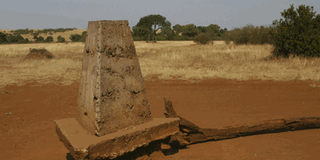Query arises over Kenya’s $1m project

Maasai Mara-Serengeti border.
What you need to know:
The Kenyan government mid this month announced to establish the customs and immigration office at the Sand River Gate, a few metres from Bologonja border with Tanzania to ease the movement of tourists.
Arusha. Kenya plans to establish a customs and immigration office along the disputed Maasai Mara-Serengeti border, raising questions on how will the project work without the involvement of Tanzania.
The Kenyan government mid this month announced to establish the customs and immigration office at the Sand River Gate, a few metres from Bologonja border with Tanzania to ease the movement of tourists.
It is understood, Tanzania had denied Kenya’s tour operators to access its national parks through Bologonja border for 40 years now.
But Kenya’s Tourism Cabinet Secretary Najib Balala said recently that the construction of the immigration office at $1 million would start soon to serve tourists travelling between the Maasai Mara Game Reserve and Serengeti National Park in Tanzania.
However, the Tanzania’s minister for Natural Resources and Tourism, Prof Jumanne Maghembe, denied Tanzania being part of such arrangement.
“We can’t interfere with the Kenya’s plan to establish customs and immigration office near Bologonja border, but such kind of plan could only work if both Kenya and Tanzania had discussed and agreed,” Prof Maghembe told this reporter over the phone.
Prof Maghembe said Tanzania was a sovereign country and its position over the Bologonja border entry remains the same, as it was when the border was closed.
Balala is quoted by the Daily Southern African Tourism Update as saying that the immigration office would clear tourists from Serengeti National Park who want to cross to Maasai Mara National Reserve or those from Maasai Mara who want to cross to Serengeti.
“Tourists will no longer need to travel all the way to Wilson Airport in Nairobi to go through the immigration procedures before being allowed into the Mara,” said Balala.
He explained that in the past, tourists from Kenya encountered challenges accessing Serengeti because the Tanzanian authorities had not relaxed rules to allow free movement.
Previously, he recalled, tourists also had to use the Narok-Nairobi or Kisii-Migori-Isebania routes to access the Namanga border point to Tanzania.
Narok governor Samuel Tunai said his county government would improve the main entrances that lead to the Maasai Mara National Reserve for wildlife lovers to easily access the park.
Bologonja, the border between Tanzania’s flagship Serengeti National Park and Maasai Mara Game Reserve of Kenya, was, until mid-1970s, a convenient route for tourists yearning to visit the Serengeti-Masai Mara ecosystem.
But following the collapse of the East African Community (EAC) in 1977, Tanzania closed all its border posts with Kenya for nearly seven years.
However, Tanzania changed its mind in mid-1980s and opened its main entry points to tourist traffic save for the Bologonja border, which remains closed to date.
Way back in 1985, the two countries signed the tourism agreement cooperation after the Arusha Summit of November16th, 1983, where it was agreed that respective local operators would only access all tourism attractions.
Article X (b), Tanzania and Kenya agreed that tourists should be transported in and out of each country through designated border posts or regional towns. Since then, the authorized border crossing points have been, Namanga, Sirari and Isebania, Holili and Taveta, and Horohoro and Lungalunga from Tanzanian and Kenyan sides respectively. The move had compelled tourists to endure nearly five-hour drive from Maasai Mara via the designated Isebania-Sirari border point to Serengeti Park.
Others have to drive back to Nairobi for an overnight stopover before proceeding to Arusha via Namanga the next day in their quest to visit the Serengeti.
However, Nairobi-based Nahdy Travel & Tours Ltd Managing Director, Faraj Abdalla said the border’s closure added substantial extra cost on the Serengeti and the Masai Mara package, as tourists had to back track the entire way via Nairobi or Arusha to reach the other side.
“The move to have tourists change vehicles at the borders of Namanga, Sirari and Taveta is not only humiliation for tourists, but also a window dressing for a Tanzania’s policy of non-tariff barriers to keep competition away,” Mr Abdalla explained.
But with the revival of the EAC and an enforcement of common market protocol that provides, among others, free movement of goods, capital and labour, Kenyans hoped that Bologonja border would be opened for tourists traffic after having closed for 40-years.
However, the Kenyans arguments have fallen in deaf ears as Tanzania had maintained that the fragile ecosystem, which is a World Heritage Site, couldn’t be sacrificed for the purpose of shortening the route between Maasai Mara and Serengeti.
Tanzania National Parks spokesperson, Mr Pascal Shelutete said that the reason why Tanzania could not open the Bolongonja border is the difference of tourism policies between the two neighboring countries.



